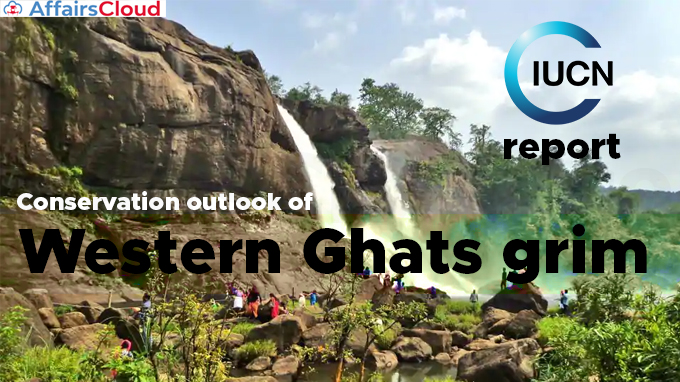 In accordance with the new report by the International Union for Conservation of Nature (IUCN) namely “IUCN World Heritage Outlook 3”, India’s Western Ghats, inscribed by UNESCO (United Nations Educational, Scientific and Cultural Organization) in 2012 as a natural world heritage site, is threatened by population pressure, urbanization and climate change. The site is regarded as of significant concern.
In accordance with the new report by the International Union for Conservation of Nature (IUCN) namely “IUCN World Heritage Outlook 3”, India’s Western Ghats, inscribed by UNESCO (United Nations Educational, Scientific and Cultural Organization) in 2012 as a natural world heritage site, is threatened by population pressure, urbanization and climate change. The site is regarded as of significant concern.
- The term significant concern in the report means the value of the site is threatened by a number of current and/or potential threats and there is a requirement of additional conservation measures in order to keep the value of site in long term.
- Notably, Western Ghats are one of the world’s eight hottest hot spots of biological diversity. The other seven are Madagascar, Philippines, Sundaland [South East Asia], Brazil’s Atlantic Forest, Caribbean, Indo-Burma, and Eastern Arc and Coastal Forests of Tanzania/Kenya.
Basis of Assessment:
The assessment of the report was based upon the previous reports from 2014 and 2017. The report has covered 252 natural World Heritage sites, as of November 2020.
- The report indicated that 63% of all sites (159) is either “good” or “good with some concerns”, while for 30% (75 sites) the outlook is of “significant concern”, and for 7% (18 sites) it is assessed as “critical”.
- A comparison of results for the 228 sites for which there are now three sets of assessments available (2014, 2017 and 2020).
What is the concern about Western Ghats?
The fragmentation caused by development pressure in the Western Ghats is decreasing the availability of wildlife corridors and suitable habitats outside protected areas. The development of new road construction, broadening of existing roads, power production, urbanization, climate change, agricultural expansion, livestock grazing are among the key factors posing threat to the site.
- As per the report, 40% of the original forests have already been destroyed.
- There is a need of functional corridors that assure wildlife movement between protected areas.
Points to be noted:
–According to UNESCO, Western Ghats is home to some of the best non-equatorial tropical evergreen forests and have at least 325 globally threatened flora, fauna, bird, amphibian, reptile and fish species.
–IUCN World Heritage Outlook is the first global assessment of natural World Heritage.
— Western Ghats are a 1,600 km long stretch of around 140,000 km² running parallel to India’s western coast, approximately 30-50 km inland, the Ghats traverse the States of Kerala, Tamil Nadu, Karnataka, Goa, Maharashtra and Gujarat.
Recent Related News:
i.On September 1, 2020, a report “Enhancing Nationally Determined Contributions (NDCs) for Food Systems” published by World Wide Fund (WWF), United Nations Environment Programme (UNEP), non-profit organization EAT & think tank Climate Focus based on strengthening food systems in the age of climate crisis.
ii.Delhi-Mumbai expressway will have India’s first five animal overpass or “animal bridges” with a combined length of over 2.5 km for safe passage of wildlife. These bridges are inspired from the Wildlife crossings in the Netherlands.
About International Union for Conservation of Nature (IUCN):
Director General– Dr Bruno Oberle
Headquarter– Gland, Switzerland




